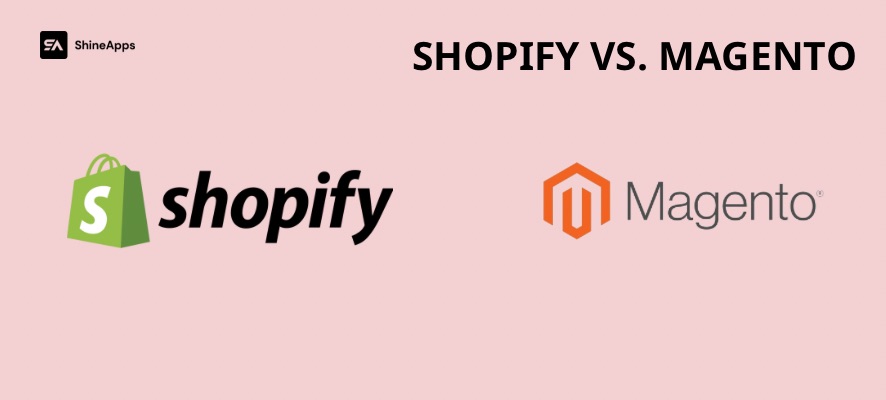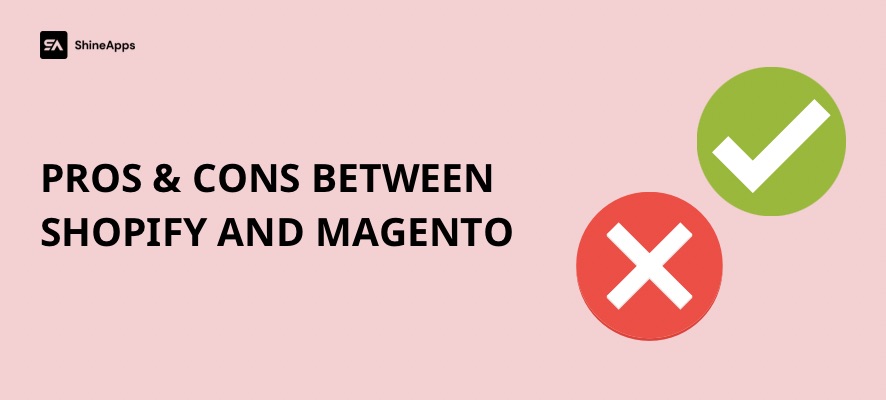Shopify and Magento are two popular ecommerce platforms on the market now. Both of them are powerful platforms; however, they have advantages and disadvantages, and you need to consider which is best for you.
What are Shopify and Magento?
Before we get started with the comparison between Shopify and Magento, we need to understand what they are and their specific target users.

Shopify
Shopify is an easy-to-use solution for building online stores without any coding skills. Online shops can access a wide range of services via the Shopify platform, including features for payments, marketing, shipping, and communication with consumers.
It can support both start-up and high-volume businesses for a monthly price. An online store can be quickly set up on Shopify with just an idea for a product to sell and a working internet connection.
Magento
Like WordPress, Magento is an open-source platform that you can install on your computer for free. Although we’ll go into more detail about these costs below, you are still going to pay for site hosting ($10 per month), security, and extensions (which serve as apps).
Although it’s an effective platform, without coding experience, it will be difficult to meet your ecommerce objectives. It works well for large companies with in-house development teams.
Pros & Cons Between Shopify and Magento

Both Shopify and Magento have their pros and cons. To find out which is best for your business plan, let’s take a look at our comparison of their advantages and disadvantages below.
Shopify
Pros | Cons |
Great for stores of all sizes
Selling across multiple channels
A lot of design themes
Numerous apps and extensions are available
Extensive payment options
24/7 customer support | There are fewer built-in features than on other platforms
High transaction fees
More expensive than it appears |
Magento
Pros | Cons |
Large user community with Magento Forum No limitation to design, if you can code Ideal for medium to large businesses | Unsuitable for individuals or small businesses to start up It is not easy to install and find a hosting provider that supports |
The comparison between Shopify and Magento
Evaluating which is better between Shopify and Magento is really hard. However, we will come across some points that are the most common problems you may be concerned about when deciding: ease of use, themes, sales tools, marketing features, apps and add-ons, payment processors and transaction fees, search engine optimization (SEO), support, and pricing.
Ease of use between Shopify and Magento

Magento is far more difficult to use than Shopify. With Shopify’s one-stop-shop, drag-and-drop website builder, you can simply customize your store by rearranging everything on the page however you like.
Compared to Shopify, Magento has a much harder learning curve. To create the online store you want, you’ll need to understand technical language and write code, or you can pay a web developer to do it for you.
Conclusion: Compared to Magento, Shopify is simpler to use. The power to customize your site however you wish with code makes Magento a better fit than Shopify, but it’s also considerably more difficult to use overall, making it challenging for most users to create a store they can be satisfied with.
Themes

The first thing customers will see when they visit your website is the theme of your online store, and website visitors rank the website design of a business as the most important sign of trust. In view of this, you should pick your template carefully in order to build trust and create a good first impression.
All of Shopify’s themes will still look amazing when viewed on a mobile device or tablet because they are all mobile-friendly. You may then go nuts with customization by adding additional pages, changing the color palette, moving and resizing items, connecting social network feeds, and more once you’ve selected your Shopify theme. All of this is possible without writing even one line of code!
Magento offers both pre-made themes that don’t need any code customization and customized themes that require a professional developer’s skills. A ready-made theme typically costs $100; however, unique themes can cost between about $600 and $25,000. Naturally, only large businesses with a lot of money should use custom themes.
Conclusion: Compared to Magento, Shopify offers a greater (and less expensive) selection of themes. Additionally, you don’t need to know how to code in order to customize Shopify’s themes, which makes it very easy for you to tailor your selected template to the needs of your business.
Sales Tools
Here are what Shopify and Magento have when comparing their sales tools with each other:
Shopify | Magento |
|
|
Conclusion: In comparison to Magento, Shopify offers a more amazing selection of sales tools. One of the best ecommerce systems available is Shopify, which includes several built-in technologies like multichannel selling, which is only available on Magento by purchasing pricey extensions.
Marketing Features

With the help of third-party integrations with companies like Segundo, Klaviyo, Constant Contact, and others, Shopify offers excellent marketing features, including the ability to launch email campaigns. On Facebook, Instagram, and Pinterest, you may sell and advertise directly. We prefer Shopify’s support for multiple language sites, which enables you to offer goods in several languages.
The majority of Magento’s marketing resources come from its Marketplace. To launch email campaigns, for example, you’ll need to install extensions like Remarkety. Additionally, if you want really customized features, you’ll probably need to rely on a web developer’s expertise to integrate your marketing tools, whereas Shopify has a lot of built-in marketing tools to help your business grow.
Conclusion: While Shopify offers social network advertising as a built-in operation, Shopify and Magento both rely on their specific app markets for the most important marketing features, such as the ability to create email campaigns.
Apps and Add-ons

Numerous commercial apps, both free and paid, are available in Shopify’s App Store for features including email marketing, shipping, social media advertising, and more.
There are many extensions available on the Magento Marketplace, and most of them are free. While some extensions can cost up to $2,000, 10% of the paid options cost around $30. Prices are different depending on the development company that developed them and whether you’ll need installation support.
Conclusion: Magento has more extensions than Shopify, but installing them requires coding expertise and runs the risk of installing a subpar extension because anybody can make them.
Payment processors and Transaction fees

Compared to Shopify Payments, Shopify supports over 100 different payment gateways, all of which have a transaction fee related to them. Popular gateways like PayPal, Stripe, Amazon Pay, and Apple Pay are just a few of them.
Magento supports more than 150 payment processors; however, most of them are designed for big organizations, like WorldPay. You only need to install them from the marketplace in order to link your store with the more common payment processors, such as Stripe or Square.
Additionally, Magento enables you to use your own Magento-based inventory while selling directly through Amazon. This is quite clever because it gives you access to the Amazon marketplace and many more customers.
Conclusion: In comparison with Shopify, Magento offers more payment processor options. If you don’t use Shopify Payments, which might be rather limited, it charges its own transaction costs and offers fewer payment gateway options.
Search Engine Optimization (SEO)

With plenty of SEO guidelines and prompts to get you started, Magento really shines in this area. To make it simpler for search engine users to locate your web pages, you can change URLs and image alt tags (which tell Google how to categorize a picture on the image search platform). These are all included features as well.
Shopify, on the other hand, depends more on applications for their SEO. While page names and picture alt tags are editable, the majority of the strategies you use for SEO must be found in the app store.
Conclusion: In terms of SEO, Magento defeats Shopify.
Support Team

In this case, Magento is the winner. Because it is meant for experienced web developers, the quality of its user instructions is excellent. Additionally, you’ll have access to SiteGround’s first-rate support. While Shopify provides excellent customer service options, it falls behind Magento and SiteGround in terms of skills.
The user community-based platform Magento includes excellent instructions for use that guide you through the steps of creating an online store. They can walk you through the process step-by-step and provide you with helpful advice from other Magento developers.
Despite the fact that Magento does not offer dedicated support, you do have access to SiteGround’s first-rate help and support staff.
Besides, Shopify offers 24/7 phone and live chat support, social media support, a community forum, email support, a help center, video tutorials, and advanced specialist support.
Pricing

The main difference between the two is that Magento is a self-hosted platform, while Shopify is a hosted platform. All of your hosting concerns are taken care of for you by a hosted platform like Shopify. With no additional work or cost on your part, all hosting costs are covered by your monthly subscription. While Magento is free to download and install, other costs, like web hosting, security, extensions, and your domain, must be handled.
There are three major pricing options offered by Shopify, each with a set monthly cost. They are Basic, Shopify, and Advance. Additionally, they also have a lite plan called Starter, which is supported only with social media, and a Plus plan, which is a custom pricing plan with personalized services.
On the other hand, various factors will affect how much Magento will cost in the end. You must pay for your site’s hosting in order to use Magento. You have a choice between three hosting packages on SiteGround.
Conclusion: Because Magento is an open-source platform, the price depends completely on your needs. Shopify, on the other hand, offers three fixed-price plans that may appear to be less expensive on the surface, but you’ll still need to pay for apps and themes.
In Conclusion
Now it’s time to answer the question, “Which is the best for you, Shopify or Magento?”
Choose Shopify if you are in these situations:
- Your purpose is to open your store as soon as possible.
- You want to upgrade from your current e-commerce website builder.
- You’re just getting started with e-commerce but want to grow it into a fully functional company.
- You would like the simplicity of a single payment and the availability of a support team.
On the other hand, choose Magento if you are:
- You want to create an online shop for your medium- or large-sized business because you are skilled in coding.
- You want unlimited freedom to create through code.
- You already have global support or plans to do so.
- You plan to build an established company that will generate revenue, and you are ready to invest both time and money in its design.
Both Shopify and Magento are great enough for their groups of users; however, they shouldn’t be used at the same time as others; for example, Shopify and WordPress support each other.
The reasons why it doesn’t make sense to use Shopify and Magento together are because they are two different platforms that do the same task! Think of Magento as a powerful content management system and Shopify as an all-in-one website builder. Without support from the other, neither platform can be sure of delivering a completely functional e-commerce site.
We are sure that you will create an online store to satisfy your customers by using whatever platform you decide is the best fit for the business you run. We’re wishing you the most suitable option!



